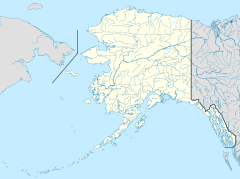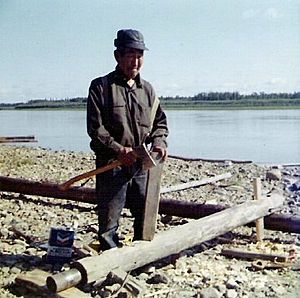Crow Village, Alaska facts for kids
Quick facts for kids
Crow Village
|
|
|---|---|
| Country | United States |
| State | Alaska |
| Census area | Bethel |
| Time zone | UTC-9 (Alaska (AKST)) |
| • Summer (DST) | UTC-8 (AKDT) |
| GNIS feature ID | 1894033 |
Crow Village is a small, unincorporated community located along the Kuskokwim River in the state of Alaska, United States. An unincorporated community means it's a place with a shared identity but no official local government. Only a few people live there today.
Where is Crow Village?
Crow Village is found in the Bethel Census Area. It sits on the north bank of the Kuskokwim River. This spot is about 6.5 miles (10.5 km) west of Aniak by river. It's also about 86 miles (138 km) northeast of Bethel, a larger town.
Who Lives in Crow Village?
| Historical population | |||
|---|---|---|---|
| Census | Pop. | %± | |
| 1880 | 59 | — | |
| 1890 | 17 | −71.2% | |
| U.S. Decennial Census | |||
The area known as Old Crow Village first appeared in the 1880 U.S. Census. It was called "Toolooka-anahamute" then. All 59 residents were Inuit people. In 1890, it was listed as "Tulukagnagamiut" with 17 Native residents.
Today, Crow Village is not part of any official census area. This means it doesn't have a formal population count. However, it's thought that only about 5 or 6 people live there now.
A Look at History
Crow Village was originally called Tulukarugmiut by the native Yup'ik people. This name means "Raven Village People." It's believed the name came from the many noisy ravens living on a nearby bluff. Over time, explorers and historians used different names for the village, but now it's simply called Crow Village.
The Kuskokwim Yup'ik people started moving inland from the Bering Sea about 500 years ago. They traveled up the Kuskokwim and Yukon Rivers. The first written record of Crow Village was in 1843. A Russian Navy officer, Lt. Lavrenty Zagoskin, explored the Alaska Interior. He described Crow Village as one of the two main villages on the Kuskokwim River. It had about 100 people living there all year.
The village sometimes moved along the riverbank as the river's path changed. It was included in the 1880 census. This was the first census to count Alaska's population after the Alaska Purchase in 1867.
Around 1910, Crow Village moved about half a mile (800 meters) downstream. This happened because the river's flow changed. This new spot was sometimes called New Crow Village. Crow Village Sam (Phillips), who would later become an important leader for the native people in the area, was a young person then. He helped with this move.
By the 1950s, Crow Village Sam was a strong leader. In 1954, he decided the village needed to be moved. This was to help with ongoing health problems. He moved the villagers 18 miles (29 km) upriver to Chuathbaluk. This village had been empty since 1929.
Digging Up the Past
Because people lived in Crow Village for a very long time, archaeologists have studied the site.
- In 1930, archaeologist Aleš Hrdlička found some bone pieces at Old Crow Village.
- In 1953, Wendell H. Oswalt collected tree ring samples at New Crow Village.
- He returned in 1954 and again in 1963 for a longer study.
- The 1963 dig was the biggest. Researchers studied five old homes in Old Crow Village. They also talked to native people, including Crow Village Sam. This helped them learn about the area's cultural history.
- Their findings are in a book called "The Ethnoarchaeology of Crow Village, Alaska." This project was special because it used archaeology to add to stories and written records. This helped create a history of the Native people.
In 1971, the Alaska Native Claims Settlement Act gave Crow Village Sam ownership of the land where Crow Village is. Later, his grandson, David Phillips, inherited this land. David and his family moved back to Crow Village in 1994.
David's oldest son, Dakota River Phillips, later found the motor of Crow Village Sam's old wind power generator. His other children, Raven Myst Phillips and Storm Hudson Phillips, found other old items, like a reindeer bell.



